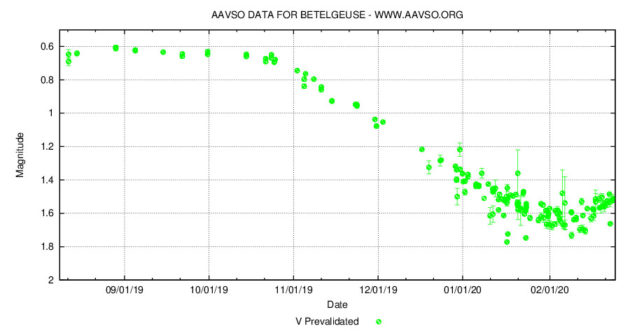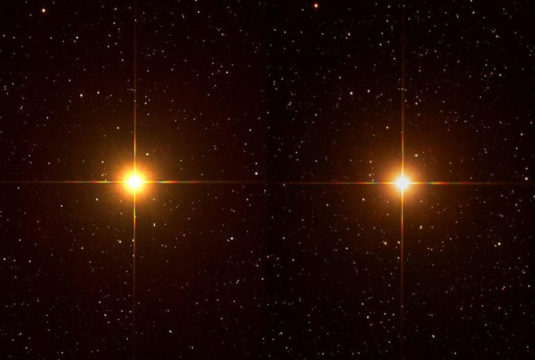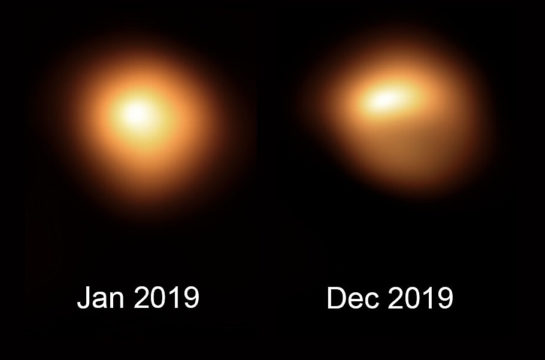With its recent uptick in brightness, Betelgeuse appears to be returning to normal. Astronomers urge us to keep watch.
After an unprecedented decline to a record-breaking minimum Betelgeuse has finally turned the corner. Astronomer Edward Guinan of Villanova University reports in Astronomer's Telegram #13512 that the star bottomed out with a mean minimum magnitude of 1.614 +/- 0.008 from February 7-13. More recent observations acquired Feb. 18-22 at the school's Wasatonic Observatory show the star brightening from 1.585 to 1.522, a clear sign of a turnaround.
Guinan points out that the present resurrection is occurring approximately 424+/-4 days after the star's last minimum in mid-December 2018 when it dimmed to magnitude 0.9. If you've been following Betelgeuse you'll know that this is just one of its several pulsation periods. The oscillations are caused by turbulence below the surface layers of the star that make it ring like a bell. They may also shift the position of or modify a large bright spot seen in photographs of the star, affecting a change in its brightness.
Observations submitted to the American Association of Variable Star Observers (AAVSO) by Thomas Calderwood show the beginnings of a brightening trend from magnitude 1.589 on Feb. 17 to 1.556 on the 19th. These and other observations this month confirm the Villanova data.

AAVSO
"Betelgeuse has definitely stopped dimming and has started to slowly brighten," writes Guinan, adding that "observations of all kinds continue to be needed to understand the nature of this unprecedented dimming episode and what this surprising star will do next."
What does it look like with the naked eye? On Feb. 25.21 UT, I compared Betelgeuse to Bellatrix (magnitude 1.6) and Aldebaran (0.9) and found it equal to Bellatrix, an increase of 0.1 magnitude from several previous estimates I'd made over the past two weeks. Yes, we have a pulse!

Brian Ottum and EarthSky
But the story of this supergiant is hardly over. Is the dip in its light caused primarily by its throbbing atmosphere or are other factors at play? In a related Telegram, a team of astronomers at the University of Minnesota report that Betelgeuse has remained "steadfast" in infrared light for a very long time. They performed infrared photometry of the star on Feb. 21, and after examining the star's spectral energy distribution — a plot of energy output versus the frequency and wavelength of the emitted light — they saw virtually no change in the star's total radiation output compared to observations made 50 years ago!

ESO / M. Montargès et al.
In other words, if you could tune your eyes to see Betelgeuse in the infrared the drama of the past few months wouldn't even register. That makes the current "fainting" unrelated to a significant change in the star's energy output. The U of M team suggests that the fading at visual wavelengths is "due mostly to local surface phenomena" such as changes in the amount and opacity of foreground dust belched out by the star along Earth's line of sight through the star's complex dust shell and atmosphere. Surface temperature fluctuations may also contribute to the fading.

ESO / L. Calçada
My favorite line in the telegram comes near the end: "Thus, while Betelgeuse may explode tomorrow or any time in the next few 1e5 yr (100,000 years), the unprecedented current visual faintness is unlikely to be a harbinger of its impending core collapse." I guess that means you can cancel that supernova party you had planned.
The group plans to continue observations and include them along with historical data in an upcoming paper. If watching Betelgeuse fade got you excited, stick around. Its return to normal may offer another taste of the unexpected.
 12
12









Comments
Michal
February 25, 2020 at 10:31 pm
Totally off topic, but the new webpage design makes for a very pleasurable read. Thank you all for the hard work and improvements over the last few months!
You must be logged in to post a comment.
Bob KingPost Author
March 2, 2020 at 11:42 am
Dear Michal,
Happy to hear it. I like it too.
You must be logged in to post a comment.
Rod
February 26, 2020 at 7:31 am
I agree
You must be logged in to post a comment.
Dmitriusz
February 26, 2020 at 8:21 am
So we see that there was a very deep minimum of regular 424-day cycle.
In next year will be very interesting to see which will be the next minimum - return to normal minimum brightness or will continue to deepen.
I prefer the second :))
You must be logged in to post a comment.
Bob KingPost Author
March 2, 2020 at 11:41 am
Dmitriusz,
Yes, it will. I'm sure we'll all be watching closely.
You must be logged in to post a comment.
Pencil BFB
February 28, 2020 at 11:32 am
A week ago, I saw Betelgeuse having around the same brightness as Bellatrix. I will observe again soon.
You must be logged in to post a comment.
Bob KingPost Author
March 2, 2020 at 11:40 am
Thanks, Pencil BFB for sharing your observation!
You must be logged in to post a comment.
goodricke1
February 29, 2020 at 6:40 pm
If "local surface phenomena such as changes in the amount and opacity of foreground dust" are the reason, then it would seem unlikely that this would follow the established 424-day cycle. These "macro" properties should be too chaotic, random and irregular.
You must be logged in to post a comment.
Bob KingPost Author
March 2, 2020 at 11:40 am
Hi goodricke1,
These are two different perspectives on the dimming from two different astronomers. Not that I know for a fact, but I suspect both causes are intertwined.
You must be logged in to post a comment.
Anthony Barreiro
March 2, 2020 at 5:27 pm
Betelgeuse's total radiation output has not changed, despite the star's historically unprecedented dimming in visual wavelengths. This is making me stop and think that there is often more going on than meets the eye. It behooves us to be humble and to always keep looking for more information and better ways to understand the data we already have.
That said, just as a casual skywatcher, Betelgeuse has made the winter of 2019-2020 very memorable!
And I love the look of the new website. Some months ago I had to turn on my ad blocker for this site to hide annoying animated gif ads that had *nothing* to do with the sky or telescopes. I just turned the ad blocker off and so far it looks like S&T has returned to your prior high standard of only accepting relevant ads. Thanks!
You must be logged in to post a comment.
misha17
March 5, 2020 at 5:50 pm
When the waxing moon's was Bellatrix or Betelguese for a couple of days earlier this week, I tried to see which star stood out more in the bright sky near the moon. Betelguese was slightly, but noticeably, brighter. Interestingly El Nath (Beta Tauri) at magnitude 1.65 is almost the same magnitude as Bellatrix (mag 1.64), but it seemed a little brighter, probably because it was further from the moon and the sky around it was darker. Even with this "advantage", Betelguese seemed to be brighter than El Nath.
You must be logged in to post a comment.
misha17
March 5, 2020 at 5:52 pm
The first line of my comment should have read, "When the waxing moon's was near Bellatrix and Betelguese" ...
You must be logged in to post a comment.
You must be logged in to post a comment.